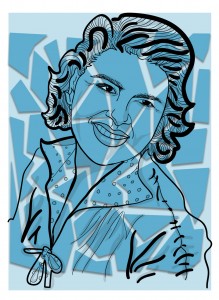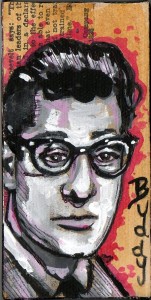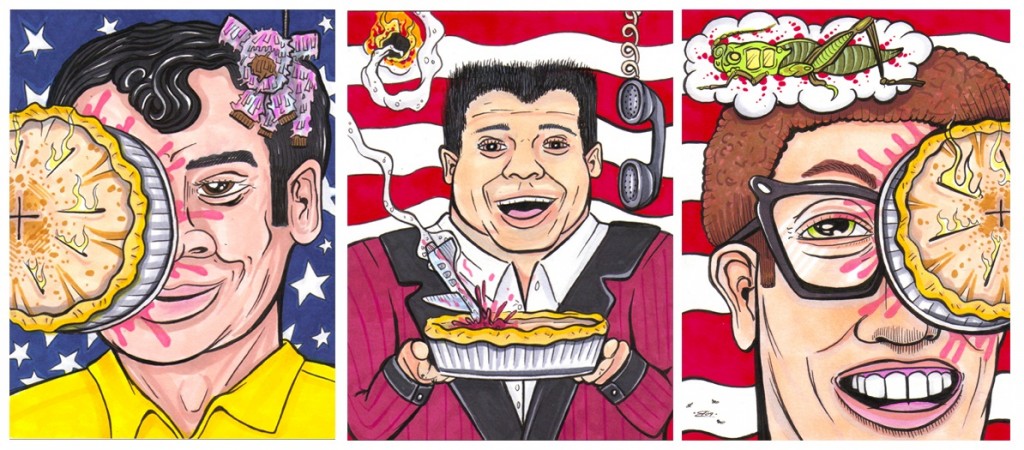In a world of condescending good ole boys, Patsy Cline refused to be anybody’s pretty little anything. Bold, forceful, and hellishly wild, she could go from cute to ugly in the flick of a cow’s tail. She assured the fellas around her, “I know how to whack below the belt.” She had to.
Growing up in the hardscrabble hills of Virginia, then kicking her way into the boys’ club at the Grand Ole Opry, there was no time for “pretty please.” Patsy came into the national spotlight at the dawn of the Women’s Lib movement, but she wouldn’t be caught dead burning bras. Her ambition propelled her far beyond domestic constraints, and besides, busting balls was more her style. She was throwing knees and elbows until her plane crashed in 1963.
Patsy grew up among the plain folk of the Shenandoah Valley, the real salt of the earth, or what a gentleman might call filthy white trash. Her mother Hilda met her husband-to-be at a Sunday school picnic when she was only thirteen years-old. He was forty. Hilda gave birth to Virginia Patterson Hensley in 1932, outside of Winchester, VA.
Little “Ginny” (as Patsy was then known) was born to shine, but her star had to claw its way up instead of shooting across the heavens. At age twelve Ginny was hacking up hens at the local poultry factory. At thirteen she fell ill with rheumatic fever, which momentarily stopped her heart and nearly killed her—but she claimed that the throat infection altered her vocal chords, giving her a “booming voice like Kate Smith’s.” She honed her pitch in the church choir, and by fourteen little Ginny was singing on the local radio station. She was also getting on with twenty-five year-old pianist, “Jumbo” Rinker. She quickly gained a reputation for getting around, but she wasn’t about to get tied down.
When she was fifteen, her ageing Daddy hit the bricks, leaving her and her young mother to take care of her brothers themselves. Little Ginny split her time between soda-jerking at the drug store and singing her heart out in honky tonks—even posing for a naughty black-and-white here and there—but no one besides local admirers seemed to notice.
Then in 1952 she met guitarist Bill Peer, who became her band-leader, her mentor, and one of her many lovers. Despite his happy marriage, Bill remained by her side through her first major performances, her first Music Row recordings, and her first record deal with Four Star. In fact, it was Bill who gave her the stage name “Patsy.” Unfortunately for Bill, it was the pudgy, yet persistent high-roller, Gerald Cline, who gave her the last name.
Gerald was eight years older, but a good deal richer than sweet Patsy. Unfortunately for Gerald, a twenty-two year-old Navy sailor was giving her the orgasms. And on show dates, so was Bill. Only one person was happy with this arrangement. Gerald wanted an apron in the kitchen, and Bill wanted a songbird on his lap. Patsy wanted to be a star, and when the heavens opened before her, she left Bill and Gerald on the ground.
After a smashing television performance on Arthur Godfrey’s Talent Scouts, Patsy was endeared to a national audience. Regular appearances on the Grand Ole Opry soon followed. Nashville was a cowboy scene where women sang duets or back up, but Patsy knocked their hats in the creek. She became the first female country artist to headline her own shows, and after her death, was the first woman to be inducted into the Country Music Hall of Fame.
It may have been a slow start, but once she got going Patsy Cline made hit records like a trailer park matriarch squirts out rug rats—just one after the other. Patsy preferred the more upbeat tunes, but her record-buying public clamored for sadness. She became the voice of heartbreak for a generation of jilted lovers. Though she generally didn’t write the lyrics, she got inside her songs in a way that bled sincerity. She would be so overcome with emotion that she often wept in the recording booth. Fellow performers remember tears streaming down her cheeks as she sang gospel tunes at the Ryman: “She was as moved as the audience.”
In 1956, Patsy performed “I’ve Loved and Lost Again” on Tex Ritter’s Western Ranch Party. This sappy little country song expresses sadness toward fickle hearts and decaying tradition, but it also heralds America’s immanent transition from domestic monogamy to the free-loving frenzy of the 60s:
To be true to one alone
don’t seem to matter anymore.
They’ll tell you you’re out of style
unless you’ve had three or four.
I’ve loved and lost again,
Oh, what a crazy world we’re living in.
True love has no chance to win…
She wears a cowgirl outfit—most likely made by her mother—with her hat cocked to cast a shadow over her eyes. A sly grin comes over her face each time she sings “unless you’ve had three or four.” For a woman like Patsy Cline, three or four is just a warm up. Before long, she would meet her next husband, and lose the Old West costume in favor of Manhattan furs and sequined gowns.
Though widely regarded as a country star, Patsy’s most popular songs saw her shed the chipper mountain yodel for a silky voice consumed with unhealthy obsession. Aside from crossover appeal in the 1960s pop charts, “Walkin’ After Midnight,” “I Fall to Pieces,” “Crazy,” and “She’s Got You” also share a common persona: the weepy romantic who refuses to move on. Cast aside by her one true love, she stares at his pictures, slips his ring onto her finger, and stalks the streets at night—trapped by a memory. The jukeboxes must have floated on rivers of tears. Hearing the genuine anguish in these songs, you have to wonder what kind of dick could string Patsy along so skillfully.
Charlie Dick was a drinker, a brawler, and a notorious ladies’ man. After his father committed suicide, he took over responsibility for his family, working hard—but playing harder. It was 1956 when he stumbled into a Virginia honky tonk to see the Kountry Krackers perform. Suddenly, Patsy Cline took the stage, and Charlie was absolutely smitten. Having just left her smothering husband, Patsy was coy with him at first. But women just couldn’t say no to Charlie Dick.
For the first time in her life, Patsy was in love. “He’s a man, all man,” she bragged to friends, “bigger than life, and twice as hard!” They were married in 1957, and their daughter Julie was born the next year. After Charlie received an honorable discharge from the Army in 1959, the couple moved to Nashville, where Patsy signed with Decca Records and joined the cast of the Grand Ole Opry. Perhaps most importantly, she met her new partner in crime—artist manager, guitar-picker, and amateur pilot, Randy Hughes. Soon she was pregnant with a baby boy—also named Randy—but that didn’t stop her relentless recording and performance schedule.
In January of 1961, Decca Records released “I Fall to Pieces,” which rocketed to the top of the charts. As Patsy’s star grew brighter, her husband’s affection withered away, but her success afforded a standard of living beyond anything they could have imagined in the backwaters of Virginia. They bought a dream house in Nashville’s suburbs, laid gold-flecked tiles in the bathroom, and filled the cabinets with bottles of booze.
Charlie often stayed at home with the kids, swilled liquor, and stewed on his slighted manhood. He hated it when his wife called him “Hoss,” and she refused to be called Patsy Dick. He was also jealous of the men in Patsy’s life—and according to many of them, rightly so. “You ought to be home being a wife,” he would yell, “instead of hauling all over singing and fooling around!” Their domestic squabbles were legendary, and according to many, would often leave Patsy bruised up or Charlie in the drunk tank. But everyone who knew them agrees that despite the misery and constant bickering, they loved each other passionately until the bitter end.
In June of ’61, Patsy was riding through Nashville with her visiting brother when a passing vehicle hit them head-on. Patsy was thrown through the windshield. Her wrist was broken, her hip dislocated, and her forehead was sliced up from eyebrow to hairline. The lingering pain from her injuries would last the rest of her life, and she would never look the same. A jagged scar slashed across her face, and the headaches came constantly. Laying in a hospital bed, she took her preacher’s hand and prayed that the experience be a lesson to her, to inspire her to find happiness at home with her family.
By August she was rolling her wheelchair into the studio, where she recorded her signature track, “Crazy.” As soon as she got back on her feet again, she was out on the road. Having conquered Music City, her manager Randy Hughes booked her from Pensacola to Canada, including the Hollywood Bowl with Johnny Cash and numerous television appearances in New York City.
Patsy’s heart broke in two every time her bawling children chased her to the door, and the furious arguments with Charlie were taking a toll, but she had to keep going, she had to bring in the money. All the while, the hits kept coming. The iron was hot, and profiteers were hammering away at her soul. She spent her last Christmas on earth doing high-dollar gigs in Las Vegas, then cried into her hotel pillow while her kids described their presents on the phone. She told Randy Hughes she was ready to slow down. Randy told her where the next show would be.
Patsy’s last performance was a benefit for the surviving family of “Cactus Jack,” Kansas City’s most popular country deejay, who had been killed in a car crash in early 1963. Her last song was also her last recording, “I’ll Sail My Ship Alone” (though all the sails you’ve torn/ and when it starts to sinkin’, I’ll blame you.) The next morning, Patsy was tired, sick, and thoroughly disillusioned. She ached to be with her family—her two year-old boy was also sick—but a thunderstorm delayed their departure. Her best friend, Dottie West, was worried about Patsy flying in Randy’s little plane through such weather, and offered to drive her back. But Patsy decided to go with Randy. “Hoss,” Patsy told Dottie, “don’t worry about me ’cause when it comes my time to go, I’m going. If that little bird goes down, I guess I’ll go down with it.”
On March 5, 1963, Randy Hughes took off from Kansas City with three Opry stars onboard: Patsy Cline, Hankshaw Hawkins, and Cowboy Copas. Randy followed behind a stormfront moving over Nashville, where their families anxiously awaited their arrival. They got lost in a stormcloud 90 miles out. Witnesses said the plane was flying erratically, cutting the tops off of pine trees before it dove straight into a hill. Search parties said the plane and crew were completely pulverized. Patsy’s bloody slip hung from a tree. Scavengers prowled among the wreckage, lifting whatever they could get their hands on. Soon the news was traveling over phone lines, the airwaves, and eventually the press.
The next day, Paul Harvey announced on his radio show: “Three familiar voices are silent today. And over an ugly hole on a Tennessee hillside, the heavens softly weep.” There was weeping from the darkest hollow to the brightest stage in Nashville. The fates had been merciful since the death of Hank Williams a decade earlier, but statistics finally caught up to Music City. Patsy’s wake was held in her dream house in Nashville, with her husband overcome with grief, her children crying out for their mother. Oddly enough, a fourth Opry star was mourned during her public memorial—news rippled through the crowds that Jack Anglin had been killed in a car accident on his way to the funeral. When it rains, it pours.
Days later, thousands of fans descended on her burial in Shenandoah Park, VA, stripping the gravesite of flower arrangements and cards in full view of the grieving family. Not that Patsy would have minded so much. With an eerie intuition, she had begun tying up loose ends and giving away her belongings in the months before her death. She kept saying she would die before turning 30, but she just made it. Having sacrificed her home life in order to ascend to the vinyl heavens, it is only fitting that her adoring fans would scour the ground for relics when she came crashing down to the earth. As one of the pallbearers noted: “It’s like a religion with them.”
© 2011 Joseph Allen
“Three Cigarettes in an Ashtray” — 1957
For further reading, see Ellis Nassour’s Honky Tonk Angel: The Intimate Story of Patsy Cline.


